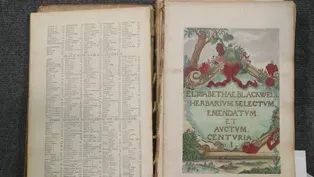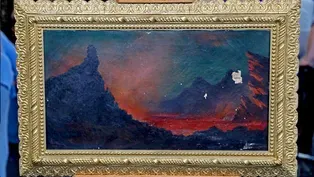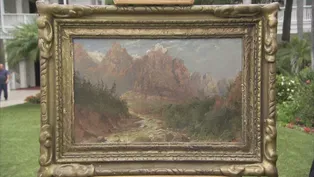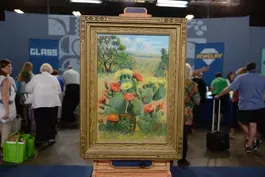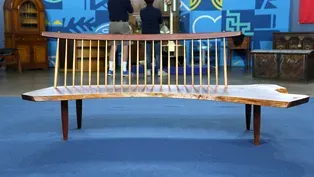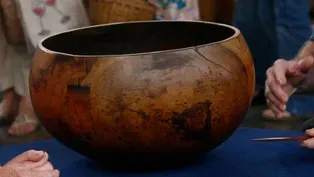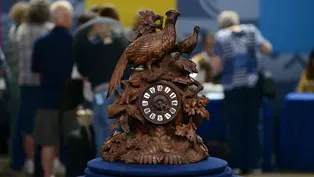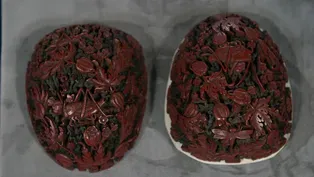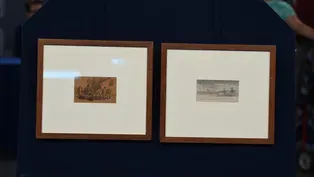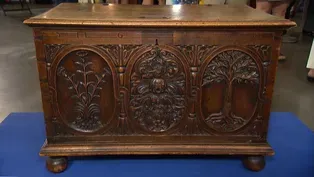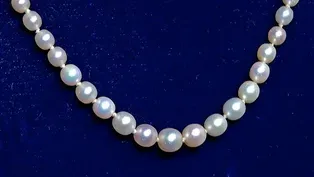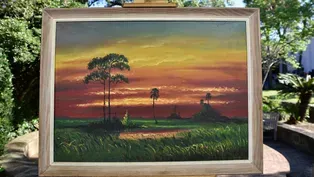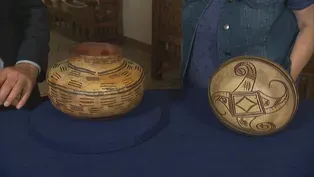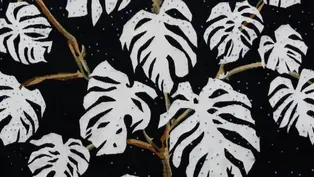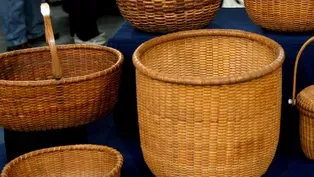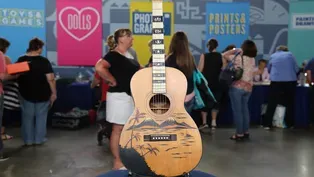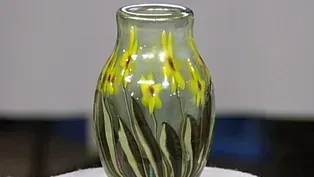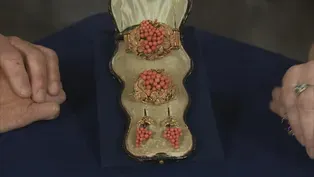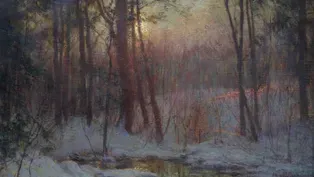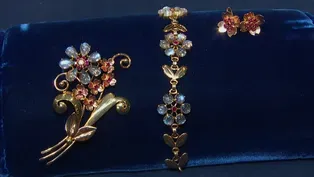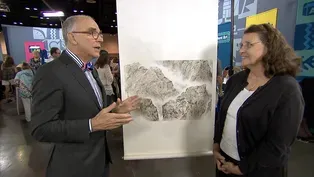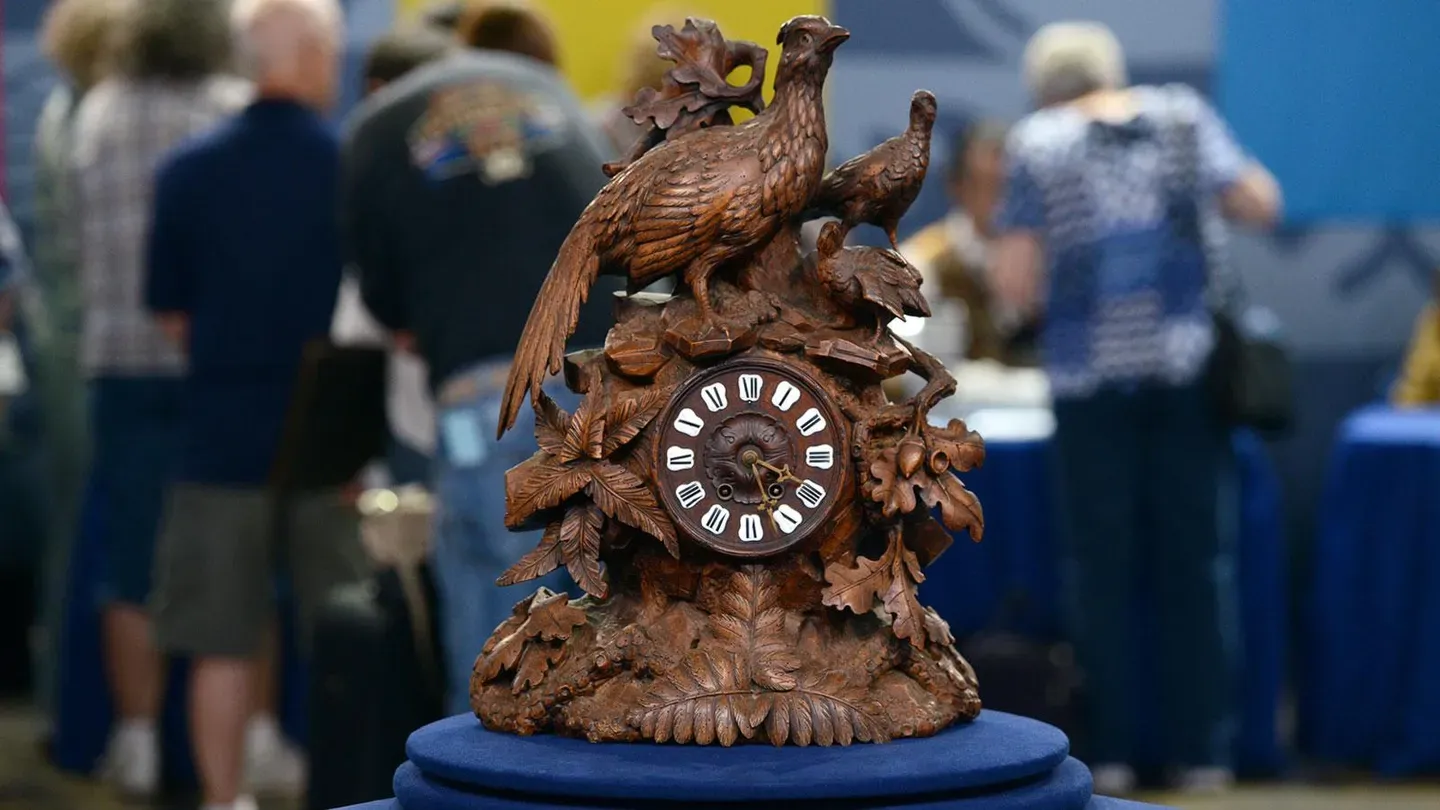

Natural Wonders
Season 26 Episode 23 | 52m 31sVideo has Closed Captions
ROADSHOW explores treasures that capture natural beauty, with finds up to $110,000!
ANTIQUES ROADSHOW explores fascinating treasures that capture the beauty and power of our natural world, including a Regal Hawaiian guitar, an 1888 Joseph Strong oil painting and a Tiffany glass vase! Guess which is $100,000 to $110,000!
Problems with Closed Captions? Closed Captioning Feedback
Problems with Closed Captions? Closed Captioning Feedback
Funding for ANTIQUES ROADSHOW is provided by Ancestry and American Cruise Lines. Additional funding is provided by public television viewers.

Natural Wonders
Season 26 Episode 23 | 52m 31sVideo has Closed Captions
ANTIQUES ROADSHOW explores fascinating treasures that capture the beauty and power of our natural world, including a Regal Hawaiian guitar, an 1888 Joseph Strong oil painting and a Tiffany glass vase! Guess which is $100,000 to $110,000!
Problems with Closed Captions? Closed Captioning Feedback
How to Watch Antiques Roadshow
Antiques Roadshow is available to stream on pbs.org and the free PBS App, available on iPhone, Apple TV, Android TV, Android smartphones, Amazon Fire TV, Amazon Fire Tablet, Roku, Samsung Smart TV, and Vizio.
Buy Now

ANTIQUES ROADSHOW 2025 Tour!
Enter now for a chance to win free tickets to ANTIQUES ROADSHOW's 2025 Tour! Plus, see which cities we're headed to!Providing Support for PBS.org
Learn Moreabout PBS online sponsorship♪ ♪ CORAL PEÑA: "Roadshow" has cultivated a wide field of treasures for nature lovers.
You do something beautiful with piece of wood that lives forever.
WOMAN: That's amazing.
Should I hug you now or later?
PEÑA: It's "Antiques Roadshow: Natural Wonders."
♪ ♪ I saw you come in with this and said, "Oh!
That's the basket of my dreams!"
(man laughing) PEÑA: Treasures made of natural materials... APPRAISER: This is an ancient Hawaiian kou wood poi calabash, and it's cut out of the crotch of a tree.
PEÑA: ...and those that capture nature's beauty... APPRAISER: I love the cactus flowers.
They bloom in one day, and then the blooms are gone.
PEÑA: ...have been cherished for centuries.
Qianlong was probably the most forward-thinking emperor of the Qing Dynasty... Really?
...and was interested very much in the natural world.
That's cool.
(both laugh) PEÑA: We're kicking off this special hour of nature appreciation with a winter scene that's actually guaranteed to warm your heart.
WOMAN: I wanted to learn about it.
I got it about 22 years ago, and I got it basically because it was a snow scene.
APPRAISER: Mm-hmm.
I bought it in a thrift store, and it was $125, which seemed like a whole lot of money at the time.
Yeah.
And I even waited a week to buy it.
And then the lady who ran the thrift store was nice enough to hold it for me for another week until my husband got paid.
And I love it because of the snow, and I just wanted more information about it.
Well, it... You know the artist.
I knew the artist, I looked it up before I bought it.
Walter Launt Palmer.
Mm-hmm, yeah, it's Walter Launt Palmer.
He was a 19th-century artist.
Do you know anything more about him at all?
His father was a sculptor, and other than that... Yeah, well, he was, he was a 19th-century artist, trained as a Hudson River School artist.
He was born in 1854 and lived till 1932.
It was painted probably around 1900.
He did almost exclusively these snow scenes, and he was very popular during his day, and he's able to capture the tones of the sunsets, the beautiful, uh, light coming through the trees.
He sort of went out of favor, but he's coming back in these days.
One thing about this painting, though, which, which is very evident, is the fact it's under glass.
Did, did you put it under the glass at all?
No, it was under glass when I purchased it.
And the paper on the back mentioned that it, had, "over fireplace in library," and I just figure somebody put glass on it to protect it... Yeah.
...from soot or something.
Right.
So we, what we have here is a really good-condition Walter Launt Palmer.
Oh, good!
You can see up in here this impasto, and it's very distinctive.
You see the brush strokes up in there, beautiful light coming through the sun and the trees.
And then also down here, we, we love the pinks and the lavenders.
You know, all these colors he's brought out of white snow.
I would recommend, at some point, having it reframed and a, and a light cleaning.
Was this the original frame?
Most likely not.
But it, it's probably been in there for at least 50 years.
So it's a terrific example of his, his work, and it's been preserved very well because of the glass.
If you brought this to me about three years ago, I would have said $20,000 to $30,000.
Uh-huh.
But he's recently spiked-- I consulted my colleagues.
Right now at auction, I'd put an estimate of $50,000 to $70,000.
Oh, no!
(giggling) Absolutely.
Oh, my...!
(laughing) How much did...
I'm serious, how much did you say?
$50,000 to $70,000.
50 to 70, oh, my... (laughs) I can't wait to tell my husband!
(laughs) (laughing) Oh, my!
Oh!
(laughing) (laughing) Now, you be careful with that on the way home, now.
Oh, he's driving.
(chuckles): He's driving.
It's okay!
Oh!
(laughs) WOMAN: My grandmother apparently purchased it in an antique store in 1930.
And when she moved back to China, she gave it to my mother, and my mother had it sitting on her dresser for, oh, gosh, ages, and she gave it to me.
So your grandmother purchased this in China?
Yes, in Peking.
I see.
And when did she come to this country?
I think she came to this country in 1950.
My grandfather had been a diplomat, so she'd been back and forth many times, but in 1950, the entire family, including me, we came from Peking to Hong Kong.
I see.
And my parents came to the United States, and my grandmother stayed in Hong Kong to take care of me.
I see.
This is a very interesting and complicated piece.
It's a piece of cinnabar lacquer.
It was made during the Qianlong period.
Do you know when that was?
(laughs): No.
Qianlong was probably the most forward-thinking emperor of the Qing dynasty.
Really?
His reign was between 1735 and 1795.
Wow.
He had a group of great imperial craftsmen working for him... Uh-huh.
...and was interested very much in the natural world.
His reign is known for gorgeous white jades... Uh-huh.
...lovely pieces of cinnabar lacquer... Uh-huh.
...scholars' objects, all with puns and rebuses and stories attached to them.
Really?
So my colleague and I were trying to figure out what the rebus is of the cricket and the melon, which, of course, reflects actually how you would find a melon in nature.
Mm-hmm.
Surrounded by crickets, and leaves, and things like this.
And we haven't quite finished our research.
But here you have a cricket.
Uh-huh.
You have a prunus here, you have melons, you have wonderful leaves all carved out of three layers of lacquer.
The first layer, and it's really not easy to see, but it is yellow, which is meant to simulate gold.
Oh!
Above that is a green lacquer.
And above this is this lovely cinnabar red color.
Each layer was applied in 100 coats.
100 coats?
You're kidding.
And then left to dry for three days... Oh!
...before the next layer was applied in a different color.
Really?
So it was a very painstaking process.
My goodness.
And look at the quality of carving.
Yes.
This quality of carving could only have been done in the Qianlong period.
Really?
And what's very interesting is that your grandmother or grandfather, or someone from your family... (laughs) ...knew that this was a, quite a fragile piece.
Yes.
So look what they said here.
"Keep this ring in place when shipping or transporting from place to place."
Yes.
(both laugh) That's great!
Cinnabar lacquer is actually not only made of layers of lacquer from a tree... Mm-hmm.
...but it has layers of fabric, as well.
At auction today... Mm-hmm.
...this item would bring between $7,000 and $10,000.
Wow, wow!
WOMAN: I came by it through my parents, and they're gone.
So it went to my sister, she's gone.
So I have it now.
(chuckles) And do you know where they, they acquired it?
My parents were traveling in Europe right after World War II.
I think he had business over there, and they came upon this in France.
Mm-hmm.
And brought it back, that was maybe the late '40s.
And do you know where in France they acquired it?
I heard it was from Aubusson.
Mm-hmm.
Where they used to make the old tapestries.
It is from Aubusson.
It is a tapestry from the mid-20th century.
I would put a date 1945 to 1950 on it.
The cartoon, which is the design of the tapestry, was done by a gentleman named Jean Lurçat, who is, without a doubt, the premier tapestry designer in France, of mid-20th-century France.
La, la!
(chuckles) He is also a painter, also was a carpet designer, but he's really best known for his tapestry designs, his cartoons, and he really was one of the driving artists behind the revitalization of the Aubusson tapestry looms in the mid-20th century, after the war, to make these very modern, fantastic pieces.
It's a handwoven tapestry weave.
They still had trained artisans in the town of Aubusson.
This particular piece, while designed by Lurçat, was made and woven by a company called Pinton Brothers, which was one of the leading Aubusson workshops in the mid-20th century.
Lurçat, his signature's here in the bottom corner, but next to it is a "P.F.," which is Pinton Frères, which is Pinton Brothers.
The name of this tapestry is "Gobi."
It's inspired by a night scene in the Gobi Desert in China.
You mean, you recognize it!
Which is why you have kind of bamboo-looking... Yeah.
...motifs through the tapestry, and these blue dots that are kind of hinting at stars as a night scene.
By the modernism of the mid-20th century, everything was highly stylized.
They were suggestions of ideas, as opposed to really naturalistic depictions.
I know a lot about Lurçat, I know a lot about Lurçat tapestries.
You do, hey.
This is one of the greatest ones I've ever seen.
(gasps): Really?
Lurçat tapestries can tend to be quite busy, a little too much going on.
This has a cleanness to it that is really, to me, the best of mid-20th century French tapestry.
Yeah, it's... Do you have any idea of value?
Well, I was thinking maybe, uh, $5,000.
The retail value is $15,000, because it's really quite a remarkable tapestry.
Whoa.
MAN: I worked in Yosemite in 1971, and I came down for a weekend to visit my folks, to bring more records back up to Yosemite.
I stopped at a flea market in Castro Valley, and I recognized the photographs, and I inquired as to how much they were and he pulled one out, and I asked him, "Who took it?"
And he gave me some line, a brother-in-law or somebody, so I kind of knew he didn't know what he had.
I didn't really know what he had, but I asked, "Did you have any more?"
He brought out two more.
I paid $1.65 for three Ansel Adams.
I think they're originals.
APPRAISER: I know you're concerned as to whether Ansel Adams actually made these prints, and I believe he did make them.
Number one, if we look in the lower right corner of this print, which is called "Nevada Falls," we see that his signature clearly appears in ink below the photograph, which is typical of display and presentation of Ansel Adams's prints.
Earlier, we looked at the back of the mount.
Mm-hmm.
And we saw that they each had a hand stamp, and that hand stamp did not have a ZIP code associated with it.
ZIP codes were introduced around 1963.
So the print date on the photographs could actually be as early as late 1950s, since the hand stamp, so clearly, is an early Ansel Adams hand stamp.
Ansel Adams revisited earlier negatives, because some of these negatives were made in the '30s and '40s, and printed, from those early negatives, prints in 14 by 11 inches.
"Merced River," 11 by 14 inches, and then "Vernal Falls," slightly smaller.
In 1970s, as he got older, he delegated the printing responsibilities to Alan Ross.
And in 1975, when Alan Ross started working with Ansel and printing from these older negatives... Mm-hmm.
...Ansel wouldn't sign his name, he would initial the prints... Oh!
...to indicate that he had seen them, that he had authorized them, but they weren't printed by him.
Let's just focus on what is here, which are three Ansel Adams photographs, probably printed in the 1960s.
At auction, this group of photographs is worth $15,000 to $25,000.
(exhales): For all three of them?
For the three together.
APPRAISER: It's a Regal, but what makes it so unusual, of course, is this double volcanoes, Hawaiian stenciled scene on the top.
MAN: Okay.
And it was originally sold as a Hawaiian guitar.
So it was intended to be played on the lap with a steel bar, and it can be converted for conventional playing style.
In a specialty guitar shop, set up for conventional playing style, this guitar would easily sell for $2,000.
Wow.
Grand!
(chuckles) That's, uh, not bad.
APPRAISER: This is the real deal.
These are what we call natural pearls.
They come out of the ocean, man had nothing to do with the formation of them.
The skin, the nacre, grows like skin on an onion.
They're very rare-- the environment's changing.
Mm-hmm.
These pearls don't come out of the water like they used to.
And the price of them has really escalated.
This market is so hot.
Mm-hmm.
Today, at auction, $5,000 to $7,000.
Whoa.
(chuckles) WOMAN: It was my husband's grandmother's, given to her on her wedding in about 1920 by her great-aunt, who acquired the bowl in the 1880s.
And it sat on my, uh, husband's grandmother's floor for 70 years.
Uh-huh.
The kids used to get in and spin around, and when they got too big, then they couldn't spin the bowl anymore.
I, I hear that story often, that's very funny.
(laughing): Oh, yeah?
Yeah.
This is an ancient Hawaiian kou wood poi calabash, an umeke poi.
These bowls, made in Hawaii, are unique in the Pacific.
Everybody throughout the Pacific ate taro, but the Hawaiians were the only people who beat it into a thick paste, almost a soup.
And therefore, they took these low bowls that are known throughout the Pacific, and made them basically into these high-walled, almost soup bowls.
The best of these poi bowls copied the gourd, and this has a wonderful organic form.
It seems-- it rests on a point, and it just seems to float upon the table.
The walls are very thin, and it's cut out of the crotch of a tree, so that you have a core here, you have a core here, and you have a third core, which, probably the branch of the tree, here.
This light sapwood that you see here dips down from the rim three times around the bowl, which gives it a wonderful swirling pattern.
So this is a hard bowl to make.
It's dramatic, made by a nameless craftsman.
We don't know when.
Sometime in ancient Hawaii, but we do know who did the repairs on it, and it has some wonderful repairs.
Now, at each core-- this is end grain on the core, so it's soft and it eventually rots out-- and they all have repairs, so your repairs are in these three areas.
These were put in in the 1880s by a man named Herrick in Honolulu.
He was a German repairman who did a huge number of bowls, like, over 30 years.
He repaired bowls for all of the elite.
His trademark is his combining three or more different patches.
There is a big wooden patch here.
Then there are some small pegs around it.
And I think over here, we can see a butterfly, and then the butterfly's peg.
So each repair itself becomes a little picture, and the bowl has a wonderful finish.
You have never touched this bowl.
It's never been refinished, so, and that's great.
It, it still retains a little bit of the shellac finish that was probably done when Herrick repaired it, which you can see on the bottom, but it has wonderful patina.
Now, what's very important in Hawaiian bowls is that you never finish the inside of the bowl.
And when you look in here, you can see that this bowl has never been touched.
I, I just think it's an outstanding piece.
And I would guess that if this bowl appeared in a Honolulu antique shop, they would, um, price it between $20,000 and $30,000.
Easily.
(inhales): Oh, my God, you're kidding.
And I would expect that it would reach the same at auction, and perhaps even more at auction.
Wow.
I think that's amazing.
I, I...
I was too rough with it.
(laughing): I'll have to treat it more kindly.
No more spinning kids.
(laughs) So you brought us an Eloise McGill.
What can you tell me about her?
She was an artist in San Antonio back in the 1880s, 1890s.
So, she...
But she was my great-great-aunt.
She's made quite a few paintings.
We have about six in our family.
We have two in our house.
When I looked her up, I realized that her full name is Eloise Polk McGill.
She has a distinguished lineage.
Some people thought she was a direct descendant of President Polk, but he did not have any children.
She's the grand-niece of Judge Baylor, who started Baylor University.
Well, I...
So she's got some connections here to Texas.
Absolutely.
She's, first studied with Robert Onderdonk in Texas.
Right.
And then, at some point later, she studied with William Merritt Chase in New York.
Ah.
Now, William Merritt Chase was a, quite a personality as a teacher.
And there are lots of little adages that he would say that would stick with his students.
(chuckles) And one of them was, "Take all the time you want to paint this painting-- take 15 minutes."
Wow.
Meaning that before you touch your brush to the canvas-- in this case, panel-- you should know exactly what the composition is going to be, and how the painting is going to develop.
So that once you start painting, you paint quickly.
Ah, interesting.
And that is extremely evident in this painting.
She's incredibly competent, secure, confident as a painter.
The artist was born in 1868, and she died about 1938.
This painting was done in the last two years of her life, and when I saw this painting, when you came up, I was blown away by the brilliant color.
Yes.
She was known for doing bluebonnets, as well.
Yes, we have one of the bluebonnets.
Well, bluebonnets are particularly popular in Texas, but I love the cactus flowers.
Cactuses, they, they bloom in one day, and then the blooms are gone.
Isn't that correct?
That's correct.
The value of this painting, for retail replacement purposes, is probably close to $20,000.
Oh!
Wow, we were hoping for a few thousand-- that's awesome.
My parents were stationed in the military, and were in La Rochelle, France, back in the early '60s, and when I was, oh, probably about ten years old, I was out with them antiquing, and we found this in an old barn, and finally was able to talk them into buying it for me, because I always loved the, all the intricate carving and everything on the clock.
They undoubtedly, uh, trusted your taste.
Yes, it was... (chuckles) Well, it's an attractive clock.
I mean, it's like eye candy, isn't it?
You know, I mean, the carving that they've put into this and all the detail and all the leaves, the birds on it, even to the acorns that are on the side, I mean, you don't still see that type of detailed work anymore.
I'm just guessing that it probably came from the Black Forest area of Germany, maybe 1900, somewhere in that, uh, timeframe.
Okay.
When we first got it, there were still some of the worm bores and so forth in it.
I see.
And it took a little while to get those killed.
Every morning, you'd get up and there'd be a little pile of sawdust.
Yeah, they have a real problem in Europe with powderpost beetle.
Uh-huh.
And that's what this is, damage from it.
I haven't seen any signs of ac, recent activity, but, uh, they are a pest over there.
Are they?
You mentioned that you sort of cleaned it up a little bit.
And I think that's what dictated, uh, the difference in color between the face itself and the body of the clock.
Mm-hmm.
It probably is a little darker at one point.
May have had a darker wax on it and everything.
Still, very attractive-looking clock.
And I guess, is this a pheasant on top?
I believe that's a pheasant, uh, with a hen and a chick.
Well, these were sort of in the taste of the Black Forest clocks of the region.
But I think this one may be even French.
Mm-hmm, okay.
And there's a couple of reasons.
One is the face of the clock-- you'll notice these little porcelain cartouche numbers here.
That's typically a French influence right there.
Okay.
And the, the second thing is the shape of the plates of the movement.
Don't you like this brickwork on the back of the...
Yes.
You know, if it was in front of a mirror, you'd get that view?
Mm-hmm.
Sort of a neat feature.
But I don't know if you noticed that the mechanism is sort of square in shape.
Uh-huh.
And that's also more of a French influence as opposed to the German influence.
Has a, what we call a count wheel strike.
Nice quality movement.
It really is not in the vein of the cuckoo clock.
Uh-huh.
This is far superior to it.
And this was a much more expensive item.
Well, it's an eight-day clock, strikes on the hour and half-hour on a bell.
Your date, I think, maybe is a little late.
I think it to be about 1880.
Oh, okay.
This has a tight enough grain.
I don't know if it's walnut or possibly alder.
Real attractive clock, I tell you.
It's impressive to see this quality of carving.
Today, I would retail this clock for $3,500.
Oh, well, very good.
Very surprising.
And how much did they pay for it?
I think it was about $20.
Boy, can you imagine how proud they would be today?
Yes, they would.
MAN: I was born on Nantucket.
My grandfather's name was Jones.
Was he related to Edward Coffin Jones?
That would be probably my great-grandfather.
Yeah, yeah.
The Coffin name on Nantucket is, like...
Huge.
Huge.
(laughs) And the Jones name is huge.
By mid-century, Edward Coffin Jones, in New Bedford, had interests in or full ownership of 15 vessels, many of them whaling vessels.
What's cool to me is that you, as a direct descendant of this great family, with Nantucket history, that these baskets, many of them have come down in the family.
Right?
I think they all have.
They call these Nantucket lightship baskets, right?
Lightship, yeah.
In about 1854 or 5, they decided that they should have a lightship, right?
Right.
25 miles off the coast.
Mm-hmm.
So that other vessels wouldn't crash...
Into the reef.
...on, on the shoals of Nantucket.
So these sailors had to be there, what, 24/7?
All... Yeah.
On the ship.
On the ship.
And what do you have to do out there?
Nothing.
(chuckles) So what do you do?
Weave baskets.
You weave baskets.
This basket right here, for instance, is an early basket.
The wooden stave coming up here with copper on the inside, the wonderful oak and ash and hickory staves.
Basketmaking, of course, moved onto the island by about 1900, even the late 19th century.
What you want to look for on some of the late 19th-, early 20th-century baskets are these brass staves here.
Yes.
And it's really tight.
Your family has kept them in good condition.
We move up in date, and as you know, this, "Antique Nantucket basket made in the 1930s by A.D. Williams" on Orange Street, Nantucket.
A well-known maker who often used poplar on the bottoms.
That's poplar wood.
Now, this basket is missing... Did you know this?
Is missing this little... No, I didn't know that.
Right there, you can see a coup... Oh, you can see where there's... Yeah, little loop handles, and they're broken off.
Mm-hmm.
This basket is made by the same man, because the technique is the same.
We have a poplar bottom and the original label on the bottom, which mentions 120 Orange Street.
And then we have just this nice, probably early 20th century, never had handles.
Condition really important.
Again, all the reeds are in good shape.
They're not busted off, because all that affects value.
In 1945, a man named José Reyes came from the Philippines, and began making baskets, and he did something different.
The earlier ones were made of oak and hickory, and ash, and he started using rattan, just like he did in the Philippines.
Here's a, a very inexpensive basket, but it is signed by him and engraved.
The one basket that he alone developed is the, uh, friendship basket.
And this is kind of a symbol of Nantucket, right?
Right.
He worked until 1980, right through the '50s, '60s, and '70s, and these originally sold for $15.
I'll go through value and I'll start out with the most recent.
This, because there's not much going on, a Reyes, at auction, is about $150 to $200.
Friendship baskets, it depends what's on top.
These are seagulls, that is ivory, and earlier on, they used whale bone.
But that's ivory and ebony.
It's a very nice rectangular shape on the bottom, and the mark is really nice.
That would bring $2,500 to $4,000.
(chuckling): Wow.
Okay?
This is a nice, clean, simple basket, worth about $1,500.
And this, because the handles are broken, this is about $500.
It would be $1,500.
Going on to this basket, that is in rough shape.
A little bit on the side, it has some damages.
Yeah, a little break in it.
Yeah, and that affects value, about $1,500 because of the damage-- it would be $2,500.
This, nice and early, very tight, is about $2,000 to $2,500.
And finally, we get to my favorite basket.
Okay?
(laughs) This is the one I saw...
The one you...
I saw you come in with this and said, "Oh, that's the basket of my dreams."
(laughs) I want to get... (laughs) You want to take that home.
Because of its rarity, because of its condition, would be worth in the range, at auction, of $6,000 to $8,000.
Hm.
And that's, that easily, it might even bring $10,000, $11,000, $12,000, $13,000.
For that one basket.
That's a lot of money for a basket.
A lot of money for a basket.
(laughs) APPRAISER: They don't have any signatures on them.
So they're just pretty snowflake brooches.
MAN: Right.
Value's gonna be about $25 apiece.
Uh-huh.
♪ ♪ It's a very good piece of Newcomb.
This scenic Newcomb landscape is, uh, a little bit rarer.
♪ ♪ Today you've brought us a really interesting painting by John Fery.
Uh, how did you acquire it?
This painting was my great-grandfather's, Charles Rendell Mabey, and he was the governor of Utah.
Oh, wow.
So he acquired this when he was in his term as governor.
The artist John Fery was born of Hungarian parents in Austria, and started his early life there, studying in Vienna and Munich.
And he comes to the United States in 1883.
He is best known for painting views of the West.
He absolutely, uh, embraced the whole landscape, and so he would go to Yellowstone, and Glacier National Park, and, uh, ultimately, Utah.
He was also known for being, uh, the artist for the Great Northern Railway.
And he painted hundreds of paintings for them, and, um, they were used as advertisement to get people to ride the rails to go west and to visit the West.
Now, this painting, uh, has an inscription on the back that dates it July 1920.
So he would still have been living in Utah at that time.
And it also has a title.
It's called "Three Patriarchs, Zion Canyon, Utah."
And the three patriarchs are the three cliffs that you see there.
Have you ever had the painting valued?
I have not.
Nor has anyone in my family, to my knowledge.
If this were being sold in a gallery, the painting would sell in the range of $25,000.
Okay.
His, his work is highly de, coveted and desired.
Um, he, uh, is best known for his views of Montana.
(exhales) But it really is a very special piece.
That's cool.
(both laughing) WOMAN: I had gone to a leftover estate sale at the Montgomery Theater here.
I looked around and didn't see anything, and I said, uh, "You don't have any jewelry around?"
And she said, "Oh, well, yeah."
And she said that there's a shoebox in there.
So she brought the shoebox out and I started looking through it, and I said, "How much do you want for this?"
And she said, "How about ten cents apiece?"
So I think I spent $1.60.
(laughing): $1.60.
(laughs) Okay, for a... For 16 pieces, basically.
Yes, but this was really the only good piece in it.
And about how long ago was this?
About 32 years ago.
About 32 years ago, okay.
(laughs) It is gold, first off, and it's composed of elements that involve these small swallows, which are enameled.
You also have these flowers with turquoise.
Okay.
And then, down here, these are carved coral that are carved in the shape of grape clusters.
Right.
Now, there are no hallmarks on the piece, but based on the style of the enameling, we can assume that this is probably a Swiss enamel necklace.
In the 19th century, the Swiss were known for their enameling techniques.
They were known to make beautiful pieces similar to this.
This piece was made between 1850 and 1860.
Oh, my.
So it's quite old.
And what I also love about the piece is that it's sort of filled with Victorian romanticism.
We've got the bird motif, which represents swallows.
Oh.
And as we know, swallows return to Capistrano every year.
Right.
And to other parts of the world, as well.
This was probably a gift given to somebody who was going away, but it was a reminder that they would also return.
Aww.
We also have the forget-me-nots.
So, someone who is going away has got a flower here that's referring to, "Do not forget me, I will return."
Isn't that nice?
Isn't that lovely?
It's a great sentiment.
Oh, gosh, yes.
And then the grape clusters, many times, this refers to bountifulness, fulfillment of a relationship or a great bounty.
So it's, it's filled with a great deal of Victorian romanticism, sentimentality.
It's actually in extremely good condition.
These pieces are very delicate.
Yeah, they are.
So it's unusual to find them in this good condition.
And because of that, this is a piece that collectors would really respond well to.
And so if this item came to auction, I would put a value on this of between $6,000 and $8,000.
You're kidding!
No, I'm not kidding.
Oh, my goodness gracious me!
(laughs) Isn't that great?
Oh, I'm rich and didn't know it.
(laughs) It's a great investment off your original ten cents.
A lot better than my IRA.
(both laugh) WOMAN: These pots were my grandmother's.
She got them on her honeymoon.
They were passed down to her daughter, which is my mother.
When my mother passed, I got them.
They are both Hopi.
They represent two generations of Hopi pottery.
Oh.
Um, the bowl closer to you was made around 1890, 1900.
Wow.
It was made at, located, called Hano Hopi.
You may have heard of the famous potter Nampeyo.
She was the grande dame of Hopi pottery.
Oh, wow!
This is not made by her.
Okay.
But it's made by somebody who surely knew her.
Mm.
And she followed some of the patterns that Nampeyo popularized.
Wow.
The designs on that bowl represent bird-feather wings, and birds are critical to Pueblo culture.
Birds associate the Native people with the upper world.
In the upper world, we have clouds.
In clouds, we have rain.
Rain comes down and produces corn.
Corn is everything in the Pueblo world.
Oh.
So we must dance for rain.
We must pray for rain.
We must beg the heavens.
Mm-hmm.
Rain.
So, this pot close to you was made for trade to non-Natives.
The pot closer to me, it's, it's a wonderful pot, and I haven't seen too many like it.
I believe it's from a period called Polacca, Polacca ware.
This began, as best I understand it, in the, uh, late 1700s... Mm-hmm.
...up until about 1890, 1900.
All right.
It's fairly thick.
It's a little cruder, not as elegantly painted... Yeah.
...as the pot close to you, and the design here is not typical.
The only thing I can think of is that these are rain indications.
Okay.
I can't explain to you why they're not coming straight down.
This bowl shows a good deal of wear.
Wear, mm-hmm.
Along the top of the rim.
This was made, I'm certain, for Native use.
It's a Native pot made to hold, perhaps, water.
Okay.
Somehow, this repetition of the same design, it's just intriguing.
I've never seen one quite like it.
Okay.
It's clearly older than the bowl made for the tourist trade.
Okay.
This bowl could be mid-1800s.
Oh, wow.
1850, 1875.
As to value, I, I believe the bowl closer to you, on a retail basis... Mm-hmm.
...would be worth in the neighborhood of $1,200 to $1,500.
(gasps) (exclaims) If you're going to insure it, I would raise it up to around $2,000.
Okay, good.
This bowl's a little more difficult to value.
I think, on a retail basis, I would value this at around $3,500.
Wow.
And if I, insuring it, I, I'd go higher.
I, you know, perhaps $4,500.
Huh!
It's, it's a wonderful pot.
That's amazing.
Should I hug you now or later?
(both laugh) That's great.
I really appreciate that.
I bought this about ten years ago at an auction.
It's by the Highwaymen, and they were a group of Black artists in South Florida in the 1950s.
Yeah.
And they would paint along the highway.
And the gentleman that was the most prominent of them-- his name was Mr. Newton-- he's the one that signed it.
We've had it hanging in our dining room for ten years.
Where was the auction?
In Fort Walton Beach, Florida.
Everybody was sitting around talking about it.
And the auctioneer, a good friend of mine, says, "Well, I'll waive my commission, the first $500 buys it."
I went... and I bought it.
Good, good for you!
It's an oil on board, so artist's board, or Masonite, in this case.
Okay.
The moniker "Highwaymen" came about because they were literally selling their paintings up and down the highway.
Oh, okay.
You know, stopping from one exit to another, going to hotels, going door to door.
They sold anywhere from $25 to $50.
(laughing): Oh, really?
What they were selling for.
And it was a group of roughly 26 artists.
Yes.
And, as you said, Harold Newton was the kind of premier, best artist of the group.
And they would paint on very inexpensive materials, and often, they would frame it with just ordinary coving, molding that you would find in houses.
They're pretty widely collected.
The wonderful part about these Highwaymen, these African American artists from Florida, is that they painted the kind of untouched landscape of Florida in the midpart of the century.
Okay.
And they started, as you said, in about the 1950s.
Yes.
Painted right through about the 1980s.
It's difficult to date this, 'cause it's not dated.
If I look at the material and the type of pickled oak frame that it has, and the way the liner is painted with this kind of whitewash, I would say it's an early one from the 1950s-- maybe the late 1950s.
They were trained, uh, pretty much by a very prominent landscape artist in, in Florida named Backus, Beanie Backus.
Oh, okay.
He was a white artist, but he loved training African American artists.
Okay.
And they got, uh, pretty successful, and they all made a living doing this.
This, I think, is a rather good one.
It's really an undisturbed landscape, there are no buildings, there are no people.
It really captures that remote, unspoiled Florida landscape of that time period.
Okay.
Today, it's so built up, as we know.
Sure.
And today, at auction, this would probably bring somewhere between $8,000 and $12,000.
(laughs) I wasn't going to say this, but, golly.
(laughs) Yeah, there's a, there's a real, uh, collecting fad for this type of art, and you nailed one of the better ones.
Congratulations.
Thank you very much.
My pleasure.
(laughing): Yeah, jeez.
♪ ♪ My family is friends of the brother of the artist.
This is Yellow Mountain, the sacred mountain Huangshan, and that's one of the places we went to visit when we were in China.
Xiaojun is considered one of the top painters in China today.
Yes.
His works sell for a pretty good amount of money.
And he does these large-scale works that sell for large amounts of money.
Yes, right.
I think this has got to be in the $50,000 to $70,000 range.
(laughing): Wow.
APPRAISER: There was a firm based in Newark, New Jersey, named Wordley, Allsopp, and Bliss.
And what they've done in this particular suite is use moonstones combined with rubies and set in 14-karat pink and yellow gold.
You would be looking at an auction value of $3,000 to $4,000.
Oh, my goodness.
It's very impressive.
Oh, that's wonderful.
WOMAN: Today I brought in a couple of, I'll call them sketches, for lack of a better word, that were given to me by a very close relative.
I just found them very interesting, and wanted to find out what they were worth.
Okay, and you know who the artist is.
Edward Bannister, I think, is his name.
Do you know where the relative got the works?
Probably an auction, possibly Rhode Island.
Well, that would make sense, because the artist, Edward Mitchell Bannister, lived in Rhode Island.
He was born around 1828 in Canada to a father, a Black man who was from Barbados, and a white woman who was of Scottish descent.
They had both died by the time he was 16.
So he ended up moving to New England in the 1840s and he did all kinds of odd jobs.
He was a cook, he was an actor, and then he ended up in Boston being a barber.
But he was interested in art, so he started taking evening classes at the Lowell Institute.
And around 1876, they had a big centennial exhibition in Philadelphia, and he won the bronze medal.
But when the judges realized he was Black, they tried to rescind the prize.
And what was interesting was that the artists who had competed with him argued in his favor, and he was able to keep the prize.
Great.
So once he won that medal, he started getting commissions and recognition, and he was able to be an artist full-time.
And he very much admired the Barbizon School.
It was a group of artists who painted landscapes in France.
And they had sort of a serene view of nature, which very much was his same point of view.
But towards the end of his life, that style of painting fell out of favor, and he really became completely obscure.
Hmm.
He died in 1901, but in the 1970s, there was the Civil Rights Movement, and that's when there was a resurgence of interest in his work.
Okay.
So here we see two works on paper.
In this one, the paper has yellowed a bit, and we see a scene with a couple of figures.
And this landscape is signed with initials in the lower right.
But what's fascinating is that he has repurposed a prescription pad, and here you can see the "Rx" up here in the corner, and the address.
It would be interesting if one would be able to find out if either of these works related to a painting that he did later on.
Mm-hmm.
The artist hasn't sold a great deal at auction, probably more oils than works on paper.
And I think, if we were to combine the value of these two works at auction, it might be something like $2,000 to $4,000.
Mm-hmm.
Maybe a bit more if we were talking about retail.
So although they don't have a terrific amount of value, they are so interesting to see, because he's a very interesting artist, and one of the very early Black artists in the history of American paintings.
Well, certainly an, an interesting history.
WOMAN: It belonged to my father, and when my father passed away, my mother had it for a while, and then she gave it to me.
APPRAISER: These herbals... Mm-hmm.
...which are very elaborate to produce, very expensive to buy...
Right, right.
...were probably done for university libraries, important private libraries...
Right.
...amateur botanists, of which there were large numbers, and physicians.
Yeah, that's what I thought.
Because all the plants in this book are of medicinal use.
Yeah, yeah.
One of the things that's so unusual about this book-- this one's by a woman.
Right, Elizabeth Blackwell.
Elizabeth Blackwell, right.
She was the wife of a physician to the king of Sweden.
And she had an interest in medical botany, and was obviously a fine artist herself.
And this book is the result of her botanical drawings over a long period of time.
This is the German edition, with the text both in German and in Latin.
Yes.
Published Nuremberg, 1757.
The nice thing about it is the hand coloring here.
Yes.
This was a common way to produce fine illustrated books in the 18th century.
Mm-hmm.
And there's gilt here.
The lettering is picked out in real gold.
Watercolor is used for the rest.
The effect is quite beautiful.
Yes.
Let's look at an internal page.
And you can tell what that plant is.
Yeah, a poppy.
A poppy.
And what was done is a copper plate engraving... Mm-hmm.
...and then a colorist would carefully hand-color the stems, the leaves, the flower.
Mm-hmm.
Let's look at another one-- a cucumber.
Right.
And cucumbers, of course, had medicinal properties... Mm-hmm.
...in the 18th century.
I don't know if they do today.
Now, let's talk a bit about conservation issues.
Okay.
Basically, the book is falling apart.
Since it's an important and a valuable old book...
Yes.
You need to have it rebound.
Right, okay.
You need to spend a few hundred dollars at least...
Okay.
...to have a good-quality binding... Mm-hmm.
...have the pages resewn.
In this present condition... Yeah?
I would still say it was worth somewhere in the range of $10,000 to $15,000.
Are you serious?
Yeah.
It's a very important botanical book.
Oh, wow.
Some of the better botanical illustrations of the 18th century are right in this book.
Oh!
In 1986, my wife gave me the book by Nakashima called "The Soul of a Tree."
And the philosophy of that book was, if you do something beautiful with a piece of wood, it lives forever.
Right.
And after reading it, I said to my wife, "I'd like to buy some of his furniture."
She says, "You're not buying anything unless I find out it's comfortable or not."
So in 1987, uh, uh, Valentine's Day, we went out to New Hope, Pennsylvania, and met George Nakashima.
And he sketched out all kinds of furniture that we might be interested in, and, uh, we ended up with 12 pieces.
And we got them in 1988, and of course, he passed away in 1990.
Yeah.
Yeah.
Well, you met probably one of the 20th century's finest furniture makers.
Right.
What you've got here is a conoid bench.
And the conoid bench is considered by most collectors to be the finest piece of the finest line that he ever did.
Good.
It's a gorgeous piece.
The grain is excellent, it's very curvilinear.
You have several great things-- you've got knots and curves.
Butterflies add value to George Nakashima furniture.
You've got a free edge along the front, you've got a free edge along the back.
All those details add value to a piece of Nakashima furniture.
The other thing that you've got on this piece that I think really adds value is the fact that this piece is signed by George Nakashima.
Having it signed by George Nakashima certainly adds value to it in today's present market.
However, it's my opinion that, that in the future, that signature that, that you have on the bottom will add even more value to it.
Mm.
Whether it's ten percent or 20% or even more, I don't know.
Everything that you would want in a piece of Nakashima, this piece has.
Do you have any idea as to what this piece might be worth?
Well, I do follow it a bit, and I would guess maybe $20,000.
What did you pay for this piece?
(chuckles) All 12 pieces, we paid $12,000-- less than $12,000 for all 12 pieces.
Yeah, yeah.
Table, chairs, all of them.
Well, I would say, at auction... Yeah.
...in today's market, this conoid bench, this wonderful conoid bench, would bring between $35,000 and $45,000.
Really?
Yes.
So in this piece, you've already tripled your money on everything.
I should have bought more.
You should have bought more, absolutely true.
(chuckling): 1987.
(chuckling): Absolutely.
WOMAN: In the 1930s, my parents went to an estate sale in New Haven, Connecticut, and they bought it.
And I know that they didn't pay much money for it, because they didn't have any money.
It's been in the family for over 60 years.
That's wonderful.
This particular glass was made at Tiffany in around 1914.
Tiffany was owned and operated by Louis Comfort Tiffany, who was the son of Charles Tiffany, the founder of Tiffany and Company.
This particular glass is called aquamarine glass.
It was produced for a very short period of time.
The glass resembles seawater.
And when they first made this, they put a lot of aquatic life in it.
Later on, they added flowers to it.
This piece is signed on the bottom.
It says "L.C.
Tiffany Favrile," and then there is a number, also.
Although the piece is signed, doesn't always mean that it is Tiffany.
But only Tiffany made aquamarine glass.
It was such a difficult technique that no one has been able to replicate it.
This was very costly to make because a lot of the pieces broke.
At the time, they would sell these for between $200 and $250, and there were very few made.
Your piece of glass is worth between $30,000 and $40,000.
(gasping) (laughs): Pretty good.
Well, I'd love to know how you acquired this painting.
I was at the Hillsville Flea Market several years ago, just walking around.
I noticed it and just liked it, and... And asked the guy what he wanted, and I bought it from him.
How much did you pay for it?
$20.
At that time, did you just take it home and... yeah?
Yeah, and, and-- and answered, why did I buy it?
Why did I part with $20 for that?
And that's why you came to the Antiques Roadshow.
That's right.
All right.
We're looking at what I think is a very rare Hawaiian volcano painting.
This is an oil on canvas.
It's signed Jos., for Joseph, Strong.
And under that, it says "HHI," and then "88."
Joseph Dwight Strong, Jr., was born in Connecticut, but by 1879, he moved to California, where he became affiliated with an important group of artists and writers and actors called the Bohemian Club.
In 1881, I believe, they had entertained Oscar Wilde in this crazy party in San Francisco.
And he was really in danger of drinking away his talent.
So right at that time, he got an important commission and he moved to Hawaii.
It's when he moved to Hawaii that he and Tavernier and some other artists formed a group.
He, they were later known as the Volcano School.
And this painting is a view of a crater of a volcano.
Hawaiian paintings are rare, and I don't mean to make a pun, but they're kind of hot right now.
(laughs) Which is great.
We have damage in this painting.
We have a hole right here.
It's, it's bad damage.
We have insect issues here.
Accretion is what we call it.
We have crackle.
It's not in great condition.
I would say that right now, his work is so rare, that despite all the damage, that this painting could bring at auction $8,000 to $12,000.
(laughing): That's good.
Better than $20.
Yeah, a lot better than $20.
PEÑA: Thanks for watching this special episode of "Antiques Roadshow."
Follow @RoadshowPBS and watch us anytime at pbs.org/antiques or on the PBS Video app.
See you next time on "Antiques Roadshow."
Appraisal: 1757 Elizabeth Blackwell Herbal
Video has Closed Captions
Clip: S26 Ep23 | 2m 31s | Appraisal: 1757 Elizabeth Blackwell Herbal (2m 31s)
Appraisal: 1888 Joseph Strong Oil Painting
Video has Closed Captions
Clip: S26 Ep23 | 2m 29s | Appraisal: 1888 Joseph Strong Oil Painting (2m 29s)
Appraisal: 1920 John Fery Oil Painting
Video has Closed Captions
Clip: S26 Ep23 | 2m 11s | Appraisal: 1920 John Fery Oil Painting (2m 11s)
Appraisal: 1937 Eloise Polk McGill "Flowering Cactus" Oil
Video has Closed Captions
Clip: S26 Ep23 | 2m 56s | Appraisal: 1937 Eloise Polk McGill "Flowering Cactus" Oil (2m 56s)
Appraisal: 1988 George Nakashima Conoid Bench
Video has Closed Captions
Clip: S26 Ep23 | 2m 37s | Appraisal: 1988 George Nakashima Conoid Bench (2m 37s)
Appraisal: Ancient Hawaiian Umeke Poi Calabash
Video has Closed Captions
Clip: S26 Ep23 | 3m 15s | Appraisal: Ancient Hawaiian Umeke Poi Calabash (3m 15s)
Appraisal: Black Forest-style French Carved Clock, ca. 1880
Video has Closed Captions
Clip: S26 Ep23 | 3m 18s | Appraisal: Black Forest-style French Carved Clock, ca. 1880 (3m 18s)
Appraisal: Cinnabar Lacquer Box, ca. 1765
Video has Closed Captions
Clip: S26 Ep23 | 3m 15s | Appraisal: Cinnabar Lacquer Box, ca. 1765 (3m 15s)
Appraisal: Edward Mitchell Bannister Sketches, ca. 1855
Video has Closed Captions
Clip: S26 Ep23 | 3m 19s | Appraisal: Edward Mitchell Bannister Sketches, ca. 1855 (3m 19s)
Appraisal: George II Walnut Chest, ca. 1720
Video has Closed Captions
Clip: S26 Ep23 | 1m 2s | Appraisal: George II Walnut Chest, ca. 1720 (1m 2s)
Appraisal: Graduated Natural Oriental Pearl Necklace
Video has Closed Captions
Clip: S26 Ep23 | 32s | Appraisal: Graduated Natural Oriental Pearl Necklace, ca. 1875 (32s)
Appraisal: Harold Newton Landscape Oil, ca. 1955
Video has Closed Captions
Clip: S26 Ep23 | 2m 35s | Appraisal: Harold Newton Landscape Oil, ca. 1955 (2m 35s)
Appraisal: Hopi Pottery Bowl & Polacca Water Jar
Video has Closed Captions
Clip: S26 Ep23 | 3m 1s | Appraisal: Hopi Pottery Bowl & Polacca Water Jar (3m 1s)
Appraisal: Jean Lurcat "Gobi" Tapestry, ca. 1950
Video has Closed Captions
Clip: S26 Ep23 | 3m 9s | Appraisal: Jean Lurcat "Gobi" Tapestry, ca. 1950 (3m 9s)
Video has Closed Captions
Clip: S26 Ep23 | 4m 33s | Appraisal: Nantucket Baskets (4m 33s)
Appraisal: Regal Hawaiian Guitar, ca. 1933
Video has Closed Captions
Clip: S26 Ep23 | 40s | Appraisal: Regal Hawaiian Guitar, ca. 1933 (40s)
Appraisal: Tiffany Aquamarine Glass Vase
Video has Closed Captions
Clip: S26 Ep23 | 1m 44s | Appraisal: Tiffany Aquamarine Glass Vase (1m 44s)
Appraisal: Victorian Coral Jewelry Suite, ca. 1860
Video has Closed Captions
Clip: S26 Ep23 | 33s | Appraisal: Victorian Coral Jewelry Suite, ca. 1860 (33s)
Appraisal: Walter Launt Palmer Painting, ca. 1900
Video has Closed Captions
Clip: S26 Ep23 | 2m 46s | Appraisal: Walter Launt Palmer Painting, ca. 1900 (2m 46s)
Appraisal: Wordley, Allsopp & Bliss Co. Jewelry Suite
Video has Closed Captions
Clip: S26 Ep23 | 32s | Appraisal: Wordley, Allsopp & Bliss Co. Jewelry Suite (32s)
Appraisal: Xiaojun Scroll Painting of Huangshan, ca. 1985
Video has Closed Captions
Clip: S26 Ep23 | 38s | Appraisal: Zeng Xiaojun Chinese Scroll Painting of Huangshan, ca. 1985 (38s)
Providing Support for PBS.org
Learn Moreabout PBS online sponsorshipSupport for PBS provided by:
Funding for ANTIQUES ROADSHOW is provided by Ancestry and American Cruise Lines. Additional funding is provided by public television viewers.


